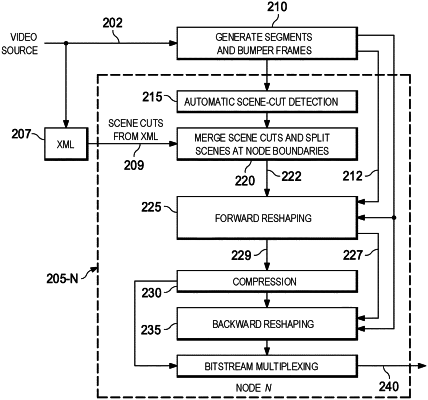| CPC G06V 20/49 (2022.01) [G06T 5/40 (2013.01); H04N 19/142 (2014.11); H04N 19/192 (2014.11); H04N 19/98 (2014.11)] | 13 Claims |

|
1. A method for segmenting a video segment into scenes using a cloud-based system for encoding high dynamic range video, the method comprising:
receiving in a current computing node of the cloud-based system a first video sequence comprising video frames in a high dynamic range;
generating for each video frame in the first video sequence a frame-based forward reshaping function mapping the video frame from the high dynamic range to a second dynamic range lower than the high dynamic range;
generating, using a set of scene cuts for the first video sequence, a set of primary scenes for the first video sequence;
generating a second set of scenes for the first video sequence based on the set of primary scenes, wherein a primary scene belonging to a parent scene with video frames to be coded across the current computing node and a neighbor computing node of the cloud-based system is divided into secondary scenes, wherein, given a primary scene, generating a list of secondary scenes for the primary scene comprises:
initializing a set of secondary scenes and a set of violation scenes based on the set of primary scenes; and
generating one or more sets of smoothness thresholds based on the frame-based forward reshaping functions, wherein generating the one or more smoothness thresholds comprises computing a first set of smoothness thresholds ℑjDC for each frame i in the first video sequence,
ℑjDC=χj−χj−1,
wherein
χj=1/H×WΣbTPF(b)×hjv(b),
wherein T _j F (b) denotes a frame-based forward reshaping function for frame-j in the first video sequence as a function of input codewords b, hjv(b) denotes a histogram of the j-th frame in the first video sequence, and H and W denote width and height values for the frames in the first video sequence;
generating for each scene in the second set of scenes a scene-based forward reshaping function mapping the video frames in the scene from the high dynamic range to the second dynamic range;
applying the scene-based forward reshaping functions to the video frames in the first video sequence to generate an output video sequence comprising video frames in the second dynamic range; and
compressing the output video sequence to generate a coded bitstream.
|